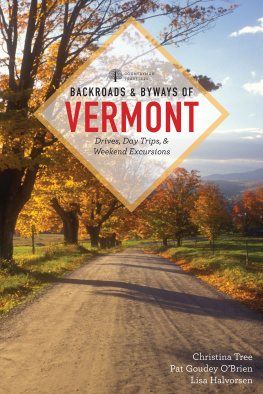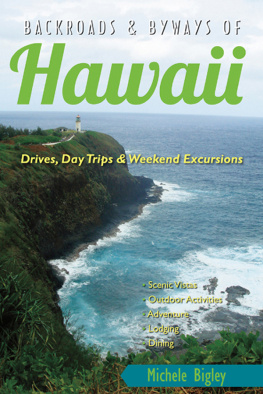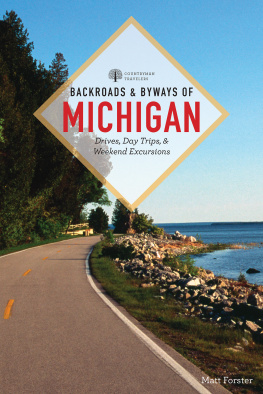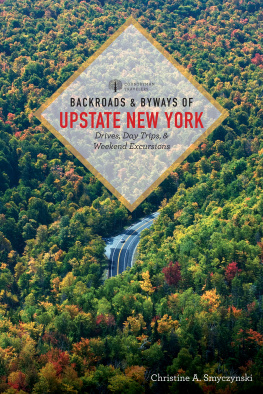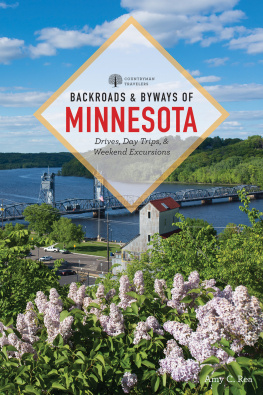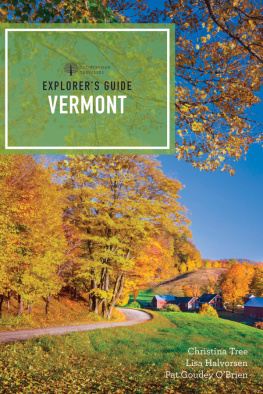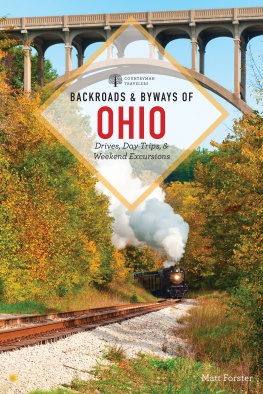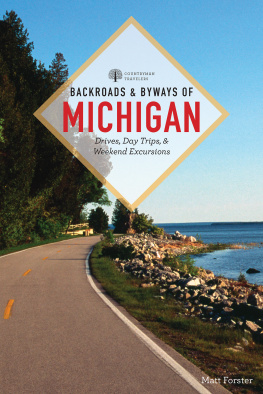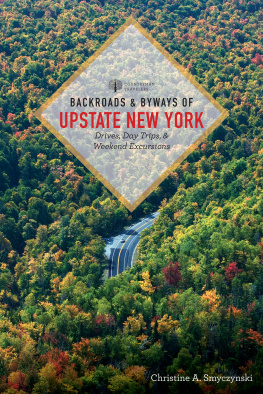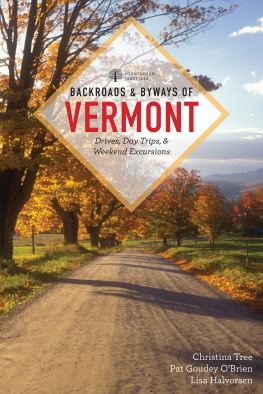

Copyright 2018 by Christina Tree
All rights reserved
For information about permission to reproduce selections from this book, write to Permissions, The Countryman Press, 500 Fifth Avenue, New York, NY 10110
For information about special discounts for bulk purchases, please contact W. W. Norton Special Sales at specialsales@wwnorton.com or 800-233-4830
Series book design by Chris Welch
Production manager: Devon Zahn
Cover series design by Steve Attardo
Cover photograph Andre Jenny / Alamy Stock Photo
The Countryman Press
www.countrymanpress.com
A division of W. W. Norton & Company, Inc.
500 Fifth Avenue, New York, NY 10110
www.wwnorton.com
978-1-68268-164-0 (pbk.)
978-1-68268-165-7 (e-book)
To my Davis family. CT
To Riley, Melanie, and David for your continued support throughout the writing of this book. LH
For Greer, one of my favorite travel companions. PGOB

Contents
THE LAY OF THE LAND
Vermont is bigger than it looks. This may be one of the countrys smallest states, but the more you drive here the more you appreciate the truth of the saying, Iron Vermont out and it would be as big as Texas.
The Green Mountains constitute one big wrinkle down the spine of this skinny state. While the Ice Age smoothed them considerably, their peaks still rise more than 4,000 feet in places. Several lower ranges and countless rounded hills rumple the flanking landscape.
Forests blanket mountainsides and steep valley walls, but farms and orchards patch hillsides and riverbanks and spread along the floor of the Champlain Valley. The states distinctive look is a blend of its natural landscape and the beauty of what has been addedthe houses, barns, churches, and meetinghouses, a large percentage of which date from 1790 to the 1850s.
THE LAY OF THE ROADS
Most major Vermont highways would be considered backroads in other states.
According to Johnathan Croft of Vermonts Agency of Transportation, Vermont roads have evolved over the course of the last 250 years or more.... Highways laid out in the late 1700s or early 1800s are still in use today and are the ubiquitous dirt roads that connect farms to villages, and villages to neighboring villages, creating a web across rural Vermont.
The majority of the states 14,000 miles of road date back to the early nineteenth century, and almost half of these miles remain unpaved. Old highways tend to follow rivers, and backroadsmany unpavedbranch off of these like so many veins off the stem of a leaf.

WILLIAMSVILLE BRIDGE
The drives we describe are predominantly paved, and the unpaved stretches can be easily circumvented. But it would be a shame not to explore unpaved roads wherever they appear along our routes. Sun dapples through the canopy of leaves on dirt roads in ways that it doesnt on pavement, and dirt roads lead to a Vermont that you rarely glimpse otherwise. Our favorite roadspaved or dirtare the gap and notch roads over the hills and mountains that connect valleys. Look quickly at their crests and you glimpse the valley below and hills beyond, and frequently mountains beyond the hills, rising in waves.
All our routes should be navigable in any vehicle that can comfortably fit through a covered bridge. And while this guide is all about backroad beauty, we also make use of Vermonts two scenic interstates as escape hatches, useful shortcuts, and access routes.
BACKROADS VS. BYWAYS
Byway has a better ring to it than backroad. Across the country, the formal recognition of hundreds of National Scenic Byways in recent decades has enabled federal funding for maintenance, signage, pullouts, visitor centers, and such. Vermont shares the Connecticut River Byway (ctriverbyways.org) with New Hampshire and promotes its own 410-mile Connecticut River Byway as one of 10 Vermont Scenic Byways (vermontvacation.com/byways). We include many of these officially scenic Vermont byways in our drives but as departure points for our roads less traveled. We use byway and backroad interchangeably.
VERMONT TOURING HISTORY
In contrast to neighboring New Hampshire, Vermont was never known in the nineteenth century for grand resorts. The era of railroads and steamboats spawned a number of lakeside inns, and both Stowe, with a hotel high on Mount Mansfield, and Manchester, with the still grand Equinox Hotel at its center, were summer destinations. More visitors, however, found their way via the wide web of railways to rural farms for extended summer stays. In the late nineteenth century, the state also promoted the sale of farms that had been abandoned by owners who headed West after the Civil War. Many urbanites snapped them up, triggering the states ongoing second-home industry.
Tourism as such began after World War I. Auto touring had come into vogue earlier, but Vermont roads were known as the worst in New England. It wasnt until after the flood of 1927which washed out a number of major highways and more than 100 covered bridgesthat the state focused on highway improvement. In the 1930s the state publicity bureau began inviting tourists to explore Unspoiled Vermont. The federally funded WPA Guide to Vermont and Let Me Show You Vermont by Charles Edward Crane, the first serious guidebooks to touring Vermont by road, appeared. There was a push to eliminate billboards and improve views from roadsides. Homes and farms throughout the state hung out signs, inviting passing tourists to spend the night.
Clearly, however, Vermonters were only willing to welcome the kind of visitors who took the trouble to navigate their roads. In 1936 a federally funded, 260-mile Green Mountain Parkway was proposed to run the length of the state, passing just below the crests of Pico, Killington, and several other peaks, but it was roundly defeated in a public referendum.
In the years following World War II, Vermonts status as a ski destination grew steadily, adding weight to the obvious need for better year-round access from urban areas. By 1970 I-89, sweeping northwest from the Connecticut River Valley to Burlington and the border, offered access from Montreal and Boston, and I-91 brought visitors from New York City and the southeast. But it took almost another decade for I-91 to creep north from White River Junction to the Canadian border. The link to I-93 came only in 1982, and put even the Northeast Kingdom within three hours of Boston.
The most recent upgrade to many Vermont roads has come in the wake of Tropical Storm Irene, which ripped through southern Vermont on August 28, 2011. It was the states most devastating natural disaster since The Great Flood of 1927. Two iconic wooden covered bridges were destroyed and more than a dozen badly damaged. More than 500 miles of road and 200 bridges required repair. Yet within a month of the storm, 84 of the 118 sections of state roads that had been closed were reopened, along with 28 of the 34 closed state bridges. Traveling backroads, especially those that follow upland streams and river valleys, you notice new bridges and erosion measures as well as miles of new paving.
TOWNS VS. VILLAGES
In northern New England, a town is defined by the territory it included when it was chartered. It can, and almost always does, contain many villages dating from different periods as population shifted over the centuries. Vermont has 251 towns, and with the exception of greater Burlington and several smaller cities, most of these are small in population and relatively large in area. Many towns began as eighteenth-century hilltop settlements that today may be almost deserted but are named on the map as the center. Some of these, such as Weathersfield Center (because of its exceptional early meetinghouse) and Brownington Center (home to the Stone House Museum), are destinations in this guide.
Next page
